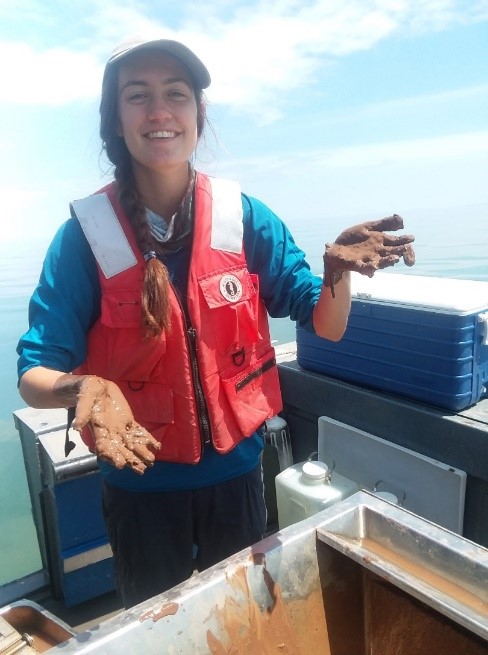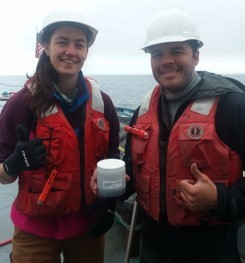Summer 2021 eNewsletter
Featured Research: Graduate Research Fellow Update
Deep-Water Quagga Mussel Nutrient Cycling in the Great Lakes
Audrey Huff, University of Minnesota Duluth

Audrey Huff is a Ph.D. student at the University of Minnesota Duluth Large Lakes Observatory (UMD LLO) and a 2020-2021 CIGLR Graduate Research Fellow. Photo Credit: Audrey Huff.
Over the past few decades, invasive zebra and quagga (dreissenid) mussels have become the dominant organism inhabiting the bottom of all the Great Lakes, apart from Lake Superior. By removing phytoplankton from the water, excreting nutrients, and changing bottom-dwelling communities, dreissenids have dramatically altered nutrient cycling regimes in the lakes. Previous research has focused on zebra mussels or “shallow-water” quagga mussels, despite the dense offshore populations of morphologically distinct “deep-water” quagga mussels. A lack of information on the bioenergetics and physiology of deep-water quagga mussels has resulted in a gap in understanding of the impacts of dreissenids on the Great Lakes ecosystem.

Onboard the R/V Blue Heron, Audrey Huff (left) and fellow UMD LLO graduate student John Zalusky (right) pose with freshly caught dreissenids. Photo Credit: Ted Ozersky.
Audrey Huff is a PhD student at the University of Minnesota Duluth Large Lakes Observatory (UMD LLO) and a 2020-2021 CIGLR Graduate Research Fellow, working with advisor Ted Ozersky (PhD, UMD LLO) and co-advisor Mark Rowe (PhD, NOAA GLERL) to determine how deep-water dreissenid populations alter carbon, nitrogen and phosphorus cycles in the Great Lakes, and to model individual deep-water quagga mussel metabolism and nutrient cycling.
In fall 2020, Audrey conducted a mesocosm experiment to determine dreissenid mussel influence on nutrient cycling at the sediment-water interface. This experiment included surface-dwelling dreissenid mussels and bottom-dwelling, bioturbating zooplankton (Diporeia) and worms (Oligochaeta). Single, double, and triple species treatments were utilized to investigate both overall and interactive influence of these organisms on nutrient flux rates to overlying water, sediment oxygen penetration depth, pore water chemistry, and physical movement of sediment. “Results from this experiment have helped provide a more complete picture of how dreissenid mussels can alter physical and chemical coupling of sediment and pelagic environments in invaded systems,” said Huff.
In addition, Audrey’s research has used shipboard experiments to study the biology of deep-water quagga mussels in the field. “In these experiments, our team quantified nitrogen and phosphorus excretion rates and respiration rates of quagga mussels collected from a wide range of depths and locations across Lakes Michigan and Huron,” said Huff. “These field data will be combined with our mesocosm study results, along with other published data, to be used in a bioenergetic model simulating deep-water quagga mussel metabolic processes.” By estimating how dreissenid carbon, nitrogen, and phosphorus excretion and egestion rates change with varying temperatures and food quality and quantity, this bioenergetic model will allow better forecasting of dreissenid contribution to whole-lake nutrient budgets under changing environmental conditions. “Results from this model will increase our understanding of the trajectory of nutrient budgets in the Great Lakes and other dreissenid-impacted ecosystems, and ultimately assist in the design of more effective management practices,” said Huff.

Researchers display a deep-water quagga mussel attached to a piece of taconite retrieved from northern Lake Huron onboard the R/V Blue Heron. Photo Credit: Audrey Huff.
About the Author
Audrey Huff is a 2020-2021 CIGLR Graduate Research Fellowship recipient and currently a PhD student at the University of Minnesota Duluth’s Large Lakes Observatory (UMD LLO). This fellowship provided Audrey with the opportunity to collaborate with NOAA GLERL scientist Dr. Mark Rowe.
Related Articles & Resources
-
- Li, J., V. Ianaiev, Huff, J. Zalusky, T. Ozersky, S. Katsev. 2021. Benthic invaders control the phosphorus cycle in the world’s largest freshwater ecosystem. Proceedings of the National Academy of Sciences. 118(6). (DOI:10.1073/pnas.2008223118).
- Vanni, M.J. 2021. Invasive mussels regulate nutrient cycling in the largest freshwater ecosystem on earth. Proceedings of the National Academy of Sciences. 118(8). (DOI:1073/pnas.2100275118).
- Boissoneault, L. 2021. Mussel-Phosphorus Puzzle: Invasive mussels are reshaping the chemistry of the Great Lakes. Great Lakes Now.
- Robideau, B. 2021. Invasive mussels now control a key nutrient in the American Great Lakes. UMN News Brief. 1/26/2021.
- Yirka, B. 2021. Quagga mussel found to be primary regulator of phosphorus cycling in lower four Great Lakes. Phys.org Report.
